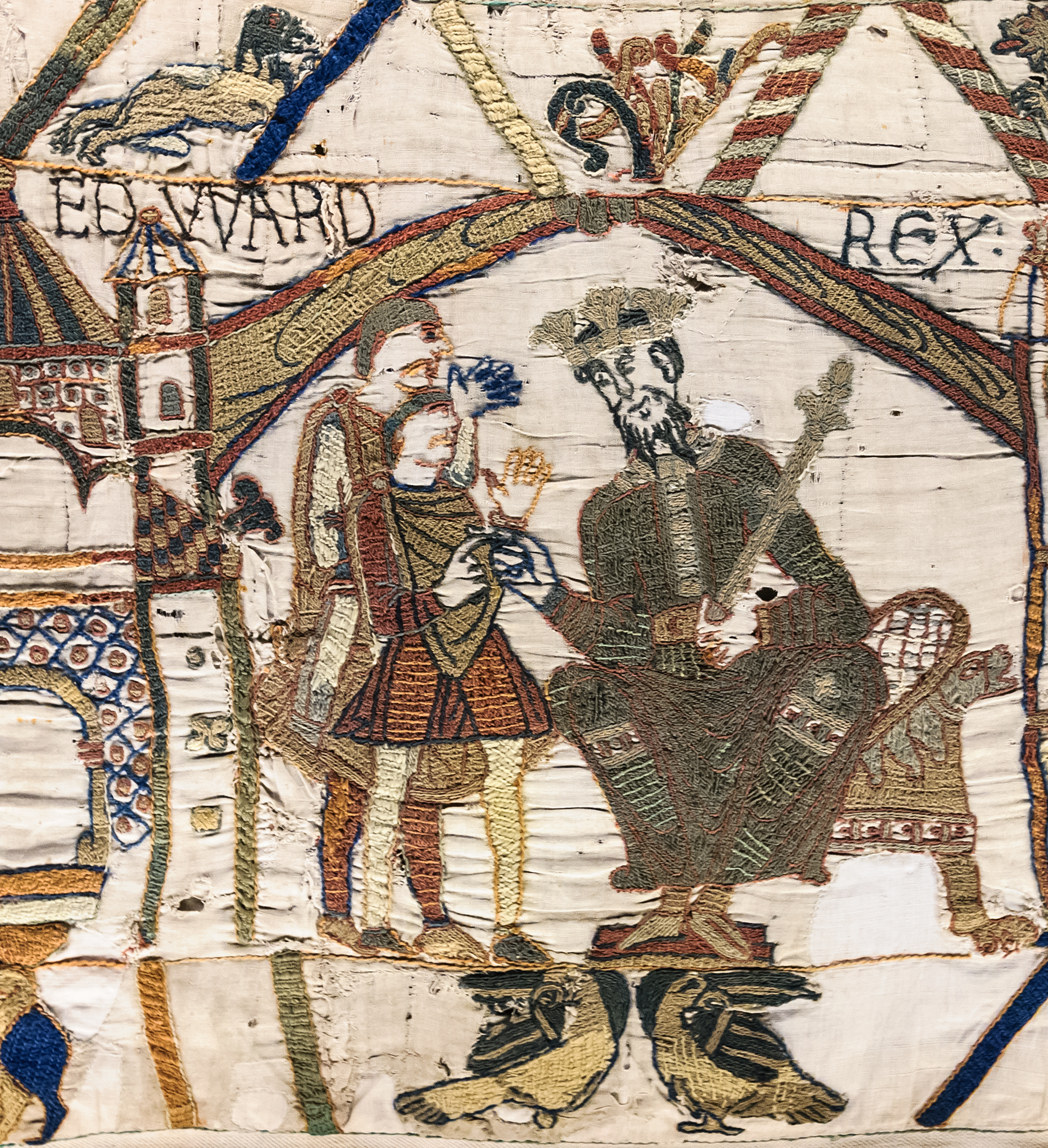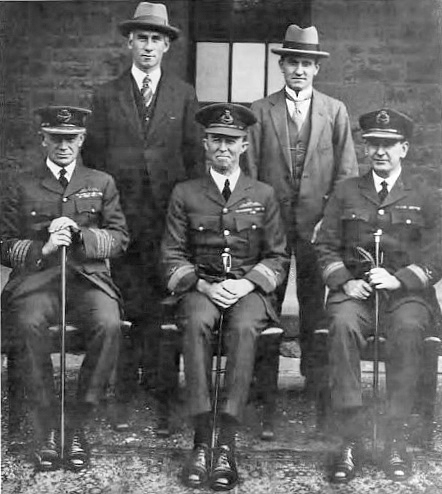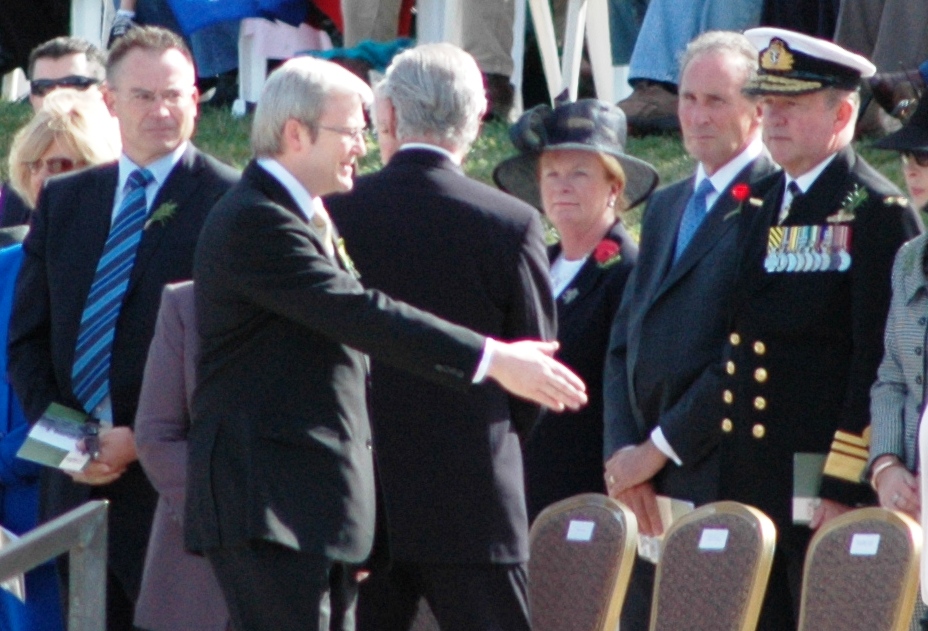|
Lieutenant General (Australia)
Lieutenant general (abbreviated LTGEN and pronounced 'lef-tenant general') is the second-highest active rank of the Australian Army. It was created as a direct equivalent of the British military rank of lieutenant general, and is considered a three-star rank. The rank of lieutenant general is held by the Chief of Army. The rank is also held when an army officer is the Vice Chief of the Defence Force, the Chief of Joint Operations, or the Chief of Joint Capabilities. The Chief of Capability Development Group, disestablished in 2016, also carried three-star rank. Lieutenant general is a higher rank than major general, but lower than general. Lieutenant general is the equivalent of vice admiral in the Royal Australian Navy and air marshal in the Royal Australian Air Force. The insignia for a lieutenant general is the Crown of St Edward above a crossed sword and baton. Australian Army lieutenants general The first Australian lieutenant general was Sir Harry Chauvel in 1917. ... [...More Info...] [...Related Items...] OR: [Wikipedia] [Google] [Baidu] |
St Edward's Crown
St Edward's Crown is the centrepiece of the Crown Jewels of the United Kingdom. Named after Saint Edward the Confessor, versions of it have traditionally been used to crown English and British monarchs at their coronations since the 13th century. The original crown was a holy relic kept at Westminster Abbey, Edward's burial place, until the regalia were either sold or melted down when Parliament abolished the monarchy in 1649, during the English Civil War. The current St Edward's Crown was made for Charles II in 1661. It is solid gold, tall, weighs , and is decorated with 444 precious and semi-precious stones. The crown is similar in weight and overall appearance to the original, but its arches are Baroque. After 1689, it was not used to crown any monarch for over 200 years. In 1911, the tradition was revived by George V and has continued ever since. In 1953, Elizabeth II opted for a stylised image of this crown to be used on coats of arms and other insigni ... [...More Info...] [...Related Items...] OR: [Wikipedia] [Google] [Baidu] |
Desert Mounted Corps
The Desert Mounted Corps was an army corps of the British Army during the First World War, of three mounted divisions renamed in August 1917 by General Edmund Allenby, from Desert Column. These divisions which served in the Sinai and Palestine Campaign had been formed by Australian light horse, British yeomanry, and New Zealand mounted rifles brigades, supported by horse artillery, infantry and support troops. They were later joined by Indian cavalry and a small French cavalry detachment. The Desert Mounted Corps (DMC) comprised the ANZAC Mounted Division, the Australian Mounted Division and the Yeomanry Mounted Division, with infantry formations attached when required, as had Desert Column. In the first month of its existence, the corps continued training and patrolling no man's land preparing for manoeuvre warfare. Their first operations would be the attack, along with the XX Corps of the Battle of Beersheba. Having captured their objective they were involved in a series ... [...More Info...] [...Related Items...] OR: [Wikipedia] [Google] [Baidu] |
Australian Defence Organisation
The Australian Defence Organisation (ADO), also known as simply Defence, is an Australian Government organisation that consists of both the Australian Defence Force (ADF) and the Department of Defence (DoD). The ADO's collective aims are to "defend Australia and its national interests" and "protect and advance Australia's strategic interests". Diarchy The Chief of the Defence Force and the Secretary of the Department of Defence jointly manage the ADO under a diarchy and report directly to the Minister for Defence, and on logistical topics, the Parliament of Australia. The ADO diarchy is a governance structure unique in the Australian Public Service. Australian Defence Force The armed forces of Australia are the Australian Defence Force, consisting of three branches: the Royal Australian Navy, Australian Army and Royal Australian Air Force. Command of the Australian Defence Force, under the direction of Defence Minister, is the primary responsibility of the Chief of the Defenc ... [...More Info...] [...Related Items...] OR: [Wikipedia] [Google] [Baidu] |
Chief Of Air Force (Australia)
Chief of Air Force (CAF) is the most senior appointment in the Royal Australian Air Force (RAAF), responsible to the Chief of the Defence Force (CDF) and the Secretary of the Department of Defence. The rank associated with the position is air marshal ( three-star). The role encompasses "the delivery of aerospace capability, enhancing the Air Force's reputation and positioning the Air Force for the future". It does not include direction of air operations, which is the purview of the Air Commander Australia, a two-star position responsible directly to CDF in such circumstances but nominally reporting to CAF. Between 1922 and 1997, the Air Force's senior officer was known as Chief of the Air Staff (CAS), a role akin to a chairman of the board. The Australian Air Board was collectively responsible for directing the RAAF, rather than the CAS personally. Wing Commander (later Air Marshal Sir) Richard Williams, often referred to as the "Father of the RAAF", was the first and longe ... [...More Info...] [...Related Items...] OR: [Wikipedia] [Google] [Baidu] |
Chief Of Navy (Australia) ...
The Chief of Navy is the most senior appointment in the Royal Australian Navy, responsible to the Chief of the Defence Force (CDF) and the Secretary of Defence. The rank associated with the position is vice admiral ( 3-star). Vice Admiral Mark Hammond is the current Chief of Navy; he assumed the position on 6 July 2022. Appointees The following list chronologically records those who have held the post of Chief of Navy or its preceding positions. Rank and honours are as at the completion of the individual's tours. Notes {{Chief of the navy by country Royal Australian Navy Royal Australian Navy admirals Leadership of the Australian Defence Force Military appointments of Australia Australia Australia, officially the Commonwealth of Australia, is a Sovereign state, sovereign country comprising the mainland of the Australia (continent), Australian continent, the island of Tasmania, and numerous List of islands of Australia, sma ... [...More Info...] [...Related Items...] OR: [Wikipedia] [Google] [Baidu] |
John Caligari
Lieutenant General John Graham Caligari, (born 21 August 1960) is a retired senior officer of the Australian Army. He served as Chief Capability Development Group from October 2014 until his retirement in August 2015. Early life Caligari was born in Brisbane, Queensland, on 21 August 1960 to Barry John Caligari, an Army officer, and his wife Christine Graham (née Wilkie). He was educated at Marist College Canberra and the International School of Kuala Lumpur, and entered the Royal Military College, Duntroon in 1979 where he undertook training to become an officer in the Australian Army.Banham, CynthiaModel of a modern digger 15 March 2008, Sydney Morning Herald , 6 August 2009, www.eurekacouncil.com.au Military career Upon graduating from Duntroon in 1982, Caligari was assigned to the < ...[...More Info...] [...Related Items...] OR: [Wikipedia] [Google] [Baidu] |
John Baker (general)
General John Stuart Baker (24 February 1936 – 9 July 2007) was a senior Australian Army officer. Entering the Royal Military College, Duntroon in 1954, his career culminated with his appointment as Chief of the Defence Force from 1995 to 1998, the most senior position in the Australian Defence Force. Baker also served as the inaugural Director of the Defence Intelligence Organisation from 1990 to 1992, Vice Chief of the Defence Force from 1992 to 1995, and was author of the highly influential 1988 "Baker Report". Career Baker entered the Royal Military College, Duntroon in 1954. On graduation in 1957, he was allotted to the Royal Australian Engineers and later completing a degree in civil engineering at the University of Melbourne. ACM Angus HoustonCDF eulogy for General John Baker AC, DSM 13 July 2007, www.defence.gov.au, accessed 31 March 2012. Baker's first regimental posting was a one-year appointment in Papua New Guinea, and not long after he spent a year in Hawa ... [...More Info...] [...Related Items...] OR: [Wikipedia] [Google] [Baidu] |
Australian Defence Force
The Australian Defence Force (ADF) is the military organisation responsible for the defence of the Commonwealth of Australia and its national interests. It consists of the Royal Australian Navy (RAN), Australian Army, Royal Australian Air Force (RAAF) and several "tri-service" units. The ADF has a strength of just over 85,000 full-time personnel and active reservists and is supported by the Department of Defence and several other civilian agencies. During the first decades of the 20th century, the Australian Government established the armed services as separate organisations. Each service had an independent chain of command. In 1976, the government made a strategic change and established the ADF to place the services under a single headquarters. Over time, the degree of integration has increased and tri-service headquarters, logistics, and training institutions have supplanted many single-service establishments. The ADF is technologically sophisticated but relatively small. Al ... [...More Info...] [...Related Items...] OR: [Wikipedia] [Google] [Baidu] |
Henry Wells (general)
Lieutenant General Sir Henry Wells, (22 March 1898 – 20 October 1973) was a senior officer in the Australian Army. Serving as Chief of the General Staff from 1954 to 1958, Wells' career culminated with his appointment as the first Chairman, Chiefs of Staff Committee, a position marking him as the professional head of the Australian Military. He served in this capacity from March 1958 until March 1959, when he retired from the army. Born in Victoria, Wells began his career in the Australian Army in 1916 when he entered the Royal Military College, Duntroon. Graduating as a lieutenant three years later, he served in a variety of staff and instructional positions before the outbreak of the Second World War. Initially posted to the 7th Division as a staff officer in 1940, Wells was promoted to lieutenant colonel and made senior liaison officer to I Corps. Serving in Greece and North Africa, he was awarded the Distinguished Service Order for his leadership at El Alamein. Transfe ... [...More Info...] [...Related Items...] OR: [Wikipedia] [Google] [Baidu] |
Chief Of The Defence Force (Australia)
The Chief of the Defence Force (CDF) is the highest-ranking and most senior military officer in the Australian Defence Force (ADF) and is the principal military advisor to the National Security Committee and the Minister for Defence. The current Chief of the Defence Force is General Angus Campbell, who took office on 6 July 2018. Responsibilities The CDF commands the ADF under the direction of the Minister for Defence and provides advice on matters that relate to military activity, including military operations. In a diarchy, the CDF serves as co-chairman of the Defence Committee, conjointly with the Secretary of Defence, in the command and control of the Australian Defence Organisation. The CDF is the Australian equivalent position of what in NATO and the European Union is known as the Chief of Defence, in the United Kingdom is known as the Chief of the Defence Staff, and in the United States is known as the Chairman of the Joint Chiefs of Staff, although with the ... [...More Info...] [...Related Items...] OR: [Wikipedia] [Google] [Baidu] |
Brudenell White
General Sir Cyril Brudenell Bingham White, (23 September 1876 – 13 August 1940), more commonly known as Sir Brudenell White or C. B. B. White, was a senior officer in the Australian Army who served as Chief of the General Staff from 1920 to 1923 and again from March to August 1940, when he was killed in the Canberra air disaster. Early life and career White was born in St Arnaud, Victoria, on 23 September 1876. He joined the colonial militia force in Queensland in 1896, and served in the Second Boer War with the Australian Commonwealth Horse. In 1901 he became a founding member of the new Australian Army, and in 1906 was the first Australian officer to attend the British Army staff college. In 1912 he returned to Australia and became Director of Military Operations, at a time when Andrew Fisher's Labor government was expanding Australia's defence capacity. First World War When the First World War broke out in August 1914, White supervised the first contingents of the A ... [...More Info...] [...Related Items...] OR: [Wikipedia] [Google] [Baidu] |




_ribbon.png)
